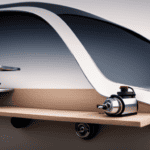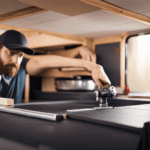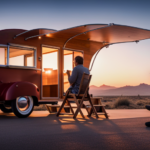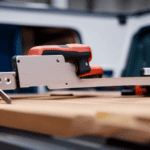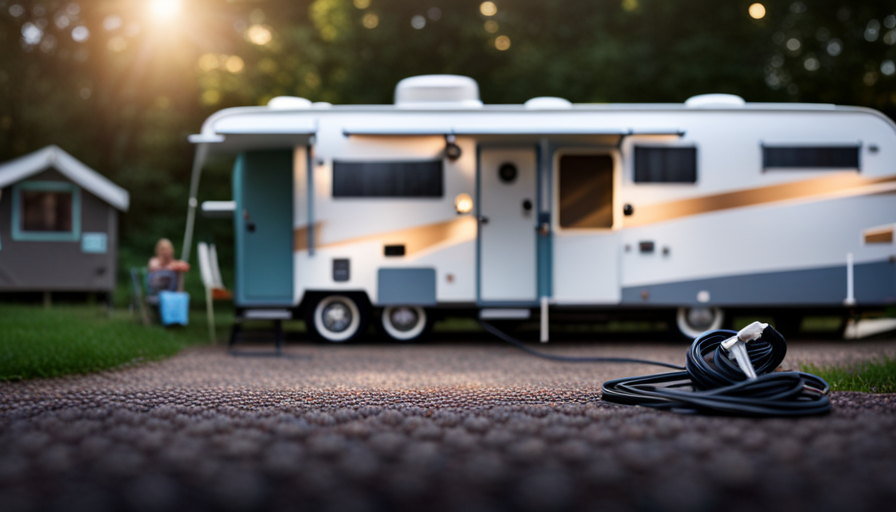Creating your own camper van is an exhilarating experience, akin to setting out on the open road with a faithful friend. Reflecting on the adage, ‘Life is a journey, not a destination,’ crafting a camper van gives you the opportunity to design distinct journeys for every new adventure you pursue.
In this guide, I will take you through the step-by-step process of building your very own camper van, from determining your needs and budget to hitting the road and enjoying the fruits of your labor. We will explore everything from choosing the right van and planning the interior layout to installing insulation, electrical systems, and appliances.
With detailed instructions and expert tips, you will have all the knowledge you need to create a cozy and functional home on wheels. So, let’s get started on this exciting journey and build the camper van of your dreams!
Key Takeaways
- Determine your needs and set a realistic budget before starting the camper van conversion.
- Choose the right van based on size, make, model, and condition.
- Install insulation and flooring to create a comfortable and cozy environment inside the van.
- Install electrical and plumbing systems for a comfortable van life experience.
Determine Your Needs and Budget
Before diving into the exciting world of camper van conversions, it’s essential to figure out your specific needs and set a realistic budget that aligns with your adventurous vision.
Determining your needs involves considering how many people will be traveling with you and what amenities you require. Are you a solo traveler who only needs a bed and a small kitchenette, or do you have a family that requires multiple beds and a bathroom? Understanding your needs will help you prioritize what features are essential and what can be sacrificed.
Setting a budget is crucial because the costs of building a camper van can quickly add up. Start by researching the average costs of materials, appliances, and labor. Consider whether you want to buy a used van and convert it yourself or purchase a pre-converted van. DIY conversions tend to be more cost-effective but require more time and effort. On the other hand, pre-converted vans offer convenience but can be pricier. It’s essential to strike a balance between your budget and your desired level of comfort and convenience.
Once you have determined your needs and set a budget, it’s time to choose the right van. This involves considering factors such as size, make, model, and condition. A reliable and spacious van will provide a solid foundation for your camper van conversion.
Choose the Right Van
When choosing the right van for your camper van conversion, there are three key points to consider.
First, think about the size and layout that will best suit your needs and preferences. This will ensure that you have enough space for all your essential amenities and a comfortable living area.
Additionally, it’s important to check the mechanical condition of the van to avoid any unexpected issues down the road.
Finally, keep an eye out for a good deal that fits your budget, as finding a van in good condition at a reasonable price can greatly impact the overall cost of your camper van project.
Consider Size and Layout
As you start planning your dream camper van, it’s time to think about the perfect size and layout that will suit your adventurous spirit.
Size considerations are crucial when choosing a van for conversion. You want to make sure it’s big enough to accommodate all your needs, but not so large that it becomes difficult to drive and park. Consider factors such as the number of people traveling with you, the amount of storage space required, and any specific features you desire, like a bathroom or kitchenette.
Layout optimization is another important aspect to consider. You want to make the most of the available space and ensure that everything is conveniently placed for easy access. Think about the placement of your bed, kitchen area, and storage compartments. A well-thought-out layout will make your camper van feel spacious and functional.
Once you have determined the ideal size and layout for your camper van, it’s time to check its mechanical condition.
Check Mechanical Condition
Little did you know, the mechanical condition of your dream camper van is about to reveal its true colors. Assessing the condition of the vehicle is crucial before embarking on your camper van conversion journey. A thorough inspection of the engine, transmission, brakes, suspension, and electrical system is necessary to ensure a smooth and safe road trip. If you’re not familiar with mechanics, finding professional help is highly recommended. They can perform a comprehensive evaluation and identify any potential issues that might arise in the future. To add depth and complexity, here is a table highlighting the key areas to check during the mechanical inspection:
| Mechanical Component | Inspection Points |
|---|---|
| Engine | Fluid levels, leaks, belts, and hoses |
| Transmission | Fluid condition, shifting smoothness |
| Brakes | Pad thickness, rotor condition |
| Suspension | Wear and tear, shocks, bushings |
| Electrical System | Battery health, wiring integrity |
Once you’ve assessed the condition of the camper van, you can confidently move on to the next step and start looking for a good deal on purchasing it. Remember, a thorough evaluation can save you from costly repairs down the road.
Look for a Good Deal
To find a great bargain, start scouring online marketplaces and local classifieds for camper vans that fit your desired specifications. Here are four key strategies to help you find affordable options and negotiate prices:
-
Be patient: Don’t rush into buying the first van you find. Take your time to compare prices and look for deals.
-
Expand your search: Consider looking in neighboring cities or towns to increase your chances of finding a good deal.
-
Negotiate: Don’t be afraid to haggle with the seller. You might be able to get a lower price or additional accessories included.
-
Consider older models: Older camper vans may require some extra maintenance, but they can often be found at a lower price point.
Once you’ve found a van that fits your budget, it’s time to start planning your interior layout.
Plan Your Interior Layout
One common concern might be the limited space, but with careful planning, you can create a functional and comfortable interior layout for your camper van.
When it comes to designing the interior, there are a few key considerations to keep in mind. First, think about the overall layout and how you want to use the space. Do you need a dedicated sleeping area? How about a kitchenette or a bathroom? Taking into account your specific needs and preferences will help you make the most of the available space.
Another important aspect to consider is storage solutions. In a small space like a camper van, maximizing storage is crucial. Look for clever storage options that utilize vertical space, such as overhead cabinets and shelves. You can also incorporate hidden storage compartments under benches or beds. Additionally, consider using multi-purpose furniture, like a table that can fold down when not in use or a bench that doubles as storage.
Once you have planned your interior layout and storage solutions, the next step is to install insulation and flooring. This will help create a comfortable and cozy environment inside your camper van.
Install Insulation and Flooring
Get ready to transform your cozy home on wheels by installing insulation and flooring that’ll keep you comfortable no matter where your adventures take you.
When it comes to insulation options for your camper van, there are a few things to consider. One popular option is spray foam insulation, which provides excellent thermal performance and can be applied to all the nooks and crannies of your van. Another option is rigid foam insulation, which is lightweight and easy to install. It’s important to choose an insulation that has a high R-value to ensure maximum heat retention.
Moving on to flooring, there are various types that work well in camper vans. Vinyl flooring is a great choice as it’s durable, waterproof, and easy to clean. It comes in a wide range of styles and colors to suit your personal taste. Another option is laminate flooring, which is also water-resistant and offers a more natural wood look. For a more eco-friendly choice, consider cork flooring, which is renewable and provides excellent insulation properties.
Now that you’ve installed insulation and flooring in your camper van, it’s time to move on to the next step: electrical and plumbing systems. These systems are essential for a comfortable van life experience and’ll allow you to have all the amenities you need on the road.
Electrical and Plumbing Systems
When it comes to building a camper van, one of the key aspects to consider is the electrical and plumbing systems.
Installing solar panels for power is essential for off-grid living, allowing you to harness the sun’s energy and power your appliances.
Setting up a water supply and plumbing system is also crucial, ensuring you have access to clean water for cooking, cleaning, and showering.
Additionally, including lighting and electrical outlets will provide convenience and comfort during your travels, allowing you to charge devices and illuminate your space.
Install Solar Panels for Power
Transform your camper van into a sustainable powerhouse by harnessing the sun’s energy and installing solar panels for a reliable source of power. Installing solar panels in your camper van has numerous benefits.
First and foremost, it allows you to generate your own electricity, reducing the need for traditional power sources. This not only saves money but also reduces your carbon footprint, making your van more eco-friendly.
Solar panels are lightweight and can easily be mounted on the roof of your van, maximizing sun exposure. They’re also durable and require minimal maintenance.
With solar power, you can power your appliances, charge your devices, and even run your air conditioning without relying on external power sources.
Now, let’s move on to the next step, where we’ll discuss how to set up a water supply and plumbing system.
Set Up a Water Supply and Plumbing System
Setting up a water supply and plumbing system in your camper van is essential for a comfortable and convenient travel experience. But how can you ensure a steady flow of water for all your needs? One important aspect is water filtration. Installing a water filtration system will ensure that the water you use for cooking, drinking, and cleaning is clean and safe. Additionally, setting up a greywater disposal system is crucial for responsible waste management. This system allows you to collect and dispose of used water in an environmentally friendly manner. To make the process easier, you can incorporate a 2 column and 5 row table to keep track of your water usage and maintenance schedule. With a properly set up water supply and plumbing system, you can now move on to include lighting and electrical outlets in your camper van for a complete and functional setup.
Include Lighting and Electrical Outlets
Including lighting and electrical outlets in your camper van is crucial for creating a comfortable and functional living space. When it comes to lighting design, it’s important to consider both natural and artificial lighting options.
Installing windows and skylights can provide ample natural light during the day, while LED lights are energy-efficient and perfect for illuminating the interior at night. Additionally, incorporating task lighting in key areas such as the kitchen and workspaces will enhance functionality.
In terms of power management, it’s essential to have a reliable electrical system. This includes installing a deep-cycle battery, a power inverter, and a solar panel to ensure a steady supply of electricity. Electrical outlets should be strategically placed throughout the camper van, allowing you to easily charge your devices and power appliances.
By including proper lighting and electrical outlets, you can create a cozy and well-lit space inside your camper van.
Now, let’s move on to building the furniture and fixtures to complete the interior design.
Build the Furniture and Fixtures
Once you’ve gathered all the necessary materials, it’s time to roll up your sleeves and start creating your very own furniture and fixtures for the camper van. Building the bed is a crucial step in making your camper van comfortable and functional. Measure the available space carefully and choose the right type of bed that suits your needs. You can opt for a fixed bed or a convertible one that can be folded into a seating area during the day. Consider using lightweight materials like plywood to ensure the bed is sturdy yet easy to move.
Next, it’s time to build the kitchen area. Start by installing a countertop that is durable and easy to clean. You can choose from various materials such as laminate, quartz, or stainless steel. Don’t forget to include a sink with a small water tank and a faucet for washing dishes. You can also add a stove or a portable cooktop for cooking meals on the road. Incorporate enough storage space for pots, pans, and utensils.
With the furniture and fixtures in place, you’re now ready to install appliances and amenities. This includes electrical outlets, lighting fixtures, and any other appliances you may need for your camper van. By taking the time to carefully design and build your own furniture and fixtures, you’ll have a camper van that perfectly fits your needs and preferences.
Install Appliances and Amenities
Now that you’ve completed the furniture and fixtures, it’s time to add the finishing touches by installing appliances and amenities that will enhance your camper van experience.
When it comes to camper van appliances, there are a few essentials you’ll want to consider. First and foremost, a reliable refrigerator is a must-have for storing food and keeping it fresh during your travels. Look for a compact, energy-efficient model that fits your space requirements. Additionally, a portable stove or cooktop will allow you to prepare meals on the road, giving you the freedom to cook wherever you park.
In terms of camper van amenities, the possibilities are endless. Consider installing a water heater and a small shower unit for those times when you need to freshen up after a long day of exploring. A toilet is another convenient amenity to have on board, especially if you plan on camping in remote areas. Don’t forget about electrical outlets and USB ports for charging your devices, as well as a ventilation fan to keep the air circulating inside the van.
With the appliances and amenities in place, you’ve created a comfortable and functional living space within your camper van. Now, it’s time to move on to the next step and customize the interior design to truly make it your own.
Customize the Interior Design
To truly make the interior of your dream home on wheels come to life, let your creativity soar as you personalize every nook and cranny of your mobile sanctuary. When it comes to the interior design of your camper van, the possibilities are endless. Whether you prefer a cozy and rustic vibe or a sleek and modern aesthetic, there are numerous interior decor ideas and space optimization tips that can help you create a space that reflects your style and meets your needs.
To make the most of the limited space in your camper van, consider incorporating multifunctional furniture and storage solutions. A 2 column and 4 row table can be a great addition to your camper van, providing both a workspace and a dining area. You can also maximize vertical space by installing shelves and hooks to keep your belongings organized and easily accessible.
In addition to furniture and storage, the colors, patterns, and textures you choose can greatly impact the overall feel of your camper van. Light colors can make the space feel larger and more open, while bold patterns and textures can add visual interest. Don’t forget to incorporate personal touches such as artwork, photographs, and plants to make your camper van feel like home.
As you customize the interior design of your camper van, don’t forget to test and make adjustments to ensure that everything is functional and comfortable.
Test and Make Adjustments
After customizing the interior design of my camper van, it was crucial to take a test drive to ensure everything was in working order.
During the test drive, I paid close attention to any issues or improvements that needed to be addressed.
Once identified, I made the necessary fixes to ensure a smooth and comfortable journey.
Take a Test Drive
Imagine the thrill of taking your own camper van for a test drive, feeling the freedom of the open road and the endless possibilities that lie ahead. Before embarking on this adventure, it’s important to understand the benefits of a test drive and have a checklist to ensure everything’s in order. Here are five reasons why a test drive is essential:
- Get a feel for the handling and comfort of your camper van.
- Check for any mechanical issues or strange noises.
- Test the functionality of all the appliances and systems.
- Evaluate the storage space and organization.
- Determine if any adjustments are needed for a smoother ride.
A test drive not only allows you to enjoy the excitement of your new camper van, but it also helps identify and fix any issues or improvements needed for a seamless journey.
Now, let’s dive into the next section and address how to identify and fix any issues or improvements.
Identify and Fix Any Issues or Improvements Needed
Embarking on the next step, let’s now delve into how you can identify and rectify any issues or improvements needed for a smoother journey with your camper van. Identifying common issues is crucial to ensure a hassle-free travel experience. From plumbing leaks to electrical malfunctions, it’s essential to troubleshoot and problem-solve effectively. To help you with this, here’s a handy table that highlights some common issues, potential causes, and suggested solutions:
| Common Issues | Potential Causes | Suggested Solutions |
|---|---|---|
| Plumbing leaks | Loose connections | Tighten fittings and replace damaged pipes |
| Electrical issues | Faulty wiring | Inspect and repair or replace faulty wires |
| Engine problems | Lack of maintenance or worn-out parts | Schedule regular maintenance and replace worn-out parts |
By following these troubleshooting and problem-solving techniques, you’ll be able to address any issues that arise. Now, let’s hit the road and enjoy your DIY camper van adventure, worry-free.
Hit the Road and Enjoy Your DIY Camper Van!
Pack up your essentials, hop in your DIY camper van, and experience the freedom of the open road as you embark on an unforgettable journey. After all the hard work you’ve put into your DIY camper van conversion, it’s time to hit the road and enjoy the fruits of your labor.
But before you start your adventure, there are a few things to keep in mind.
Firstly, make sure you have all the necessary supplies for your road trip. Stock up on groceries, water, and other essentials before you leave. It’s also a good idea to have a toolbox and spare parts in case of any unforeseen issues.
Next, familiarize yourself with your camper van. Take some time to understand the layout, the electrical system, and how everything works. This will help you troubleshoot any potential problems that may arise during your journey.
When it comes to road trips in a camper van, planning is key. Research campgrounds and parking spots along your route, and make reservations if necessary. Additionally, consider investing in a good GPS or navigation app to help you find your way.
Remember to take it slow and enjoy the journey. Camper van travel is all about embracing the freedom and flexibility it offers. Stop at scenic viewpoints, explore charming towns, and make memories along the way.
So, pack your bags, buckle up, and get ready for the adventure of a lifetime in your DIY camper van. The open road awaits!
Frequently Asked Questions
What are some common challenges or obstacles people face when building their own camper van?
Common mistakes and challenges people often face when building their own camper van include underestimating the budget required, overlooking necessary permits and regulations, and not properly planning the layout and design.
Budgeting tips can help avoid financial strain, such as researching costs for materials and equipment, considering second-hand options, and factoring in unexpected expenses.
It’s crucial to be knowledgeable and detailed in order to tackle these obstacles successfully and create a camper van that meets your needs and expectations.
How do I ensure that my camper van meets legal and safety requirements?
Ensuring compliance with legal and safety regulations is crucial when building a camper van. To meet these requirements, start by researching the specific regulations in your area for vehicle conversions. This will include guidelines for electrical systems, gas installations, seating arrangements, and more.
It’s also important to consult professionals or experienced builders for advice and guidance. Regular inspections and maintenance are necessary to ensure ongoing compliance and the safety of yourself and others on the road.
Can I build a camper van if I have limited DIY skills or experience?
If you have limited DIY skills or experience, building a camper van may seem daunting. However, you’ll be surprised to know that 60% of people who build their own camper vans have little to no prior experience. It’s all about finding the right resources and support.
There are numerous online communities, forums, and tutorials that provide step-by-step guidance. Additionally, local workshops and classes can help you gain the necessary skills.
With determination and the right resources, anyone can build their own camper van.
What are some tips for maximizing space and storage in a small camper van?
To maximize space in a small camper van, clever storage solutions and multi-purpose furniture are key. Utilize every nook and cranny by installing shelves, hooks, and storage bins. Consider using collapsible or stackable containers to save space. Opt for furniture that serves multiple functions, such as a bed that can fold into a sofa or a dining table that doubles as a workspace.
Don’t forget to utilize the vertical space by installing overhead storage compartments. These strategies will help you make the most of your limited space in a small camper van.
Are there any specific considerations or modifications I should make if I plan to travel with pets in my camper van?
When it comes to traveling with pets in a camper van, there are a few tips and considerations to keep in mind. First, ensure your pet’s safety by securing them with a harness or crate.
Create a pet-friendly space by including comfortable bedding, toys, and a designated area for food and water. Additionally, it’s important to plan for regular exercise and potty breaks during your travels.
Taking these steps will ensure a happy and stress-free journey for both you and your furry friend.
What Steps Should I Follow to Build My Own Camper Van?
Building a camper van involves several steps. First, determine your budget and research suitable vans. Next, plan the layout, considering your needs for sleeping, cooking, and storage. Purchase necessary equipment including insulation, flooring, and utilities. Install windows, electrical system, and plumbing, if desired. Finally, add furniture, appliances, and decorate to make it your own.
Conclusion
After months of hard work and dedication, I’m now the proud owner of my very own camper van. As I sit behind the wheel, the scent of new upholstery fills the air.
The cozy interior is a perfect balance of functionality and style, with every inch meticulously planned and executed.
The road stretches out before me, beckoning me to embark on new adventures. I’m ready to embrace the freedom and beauty of the open road, knowing that I’ve created my own little haven on wheels.



